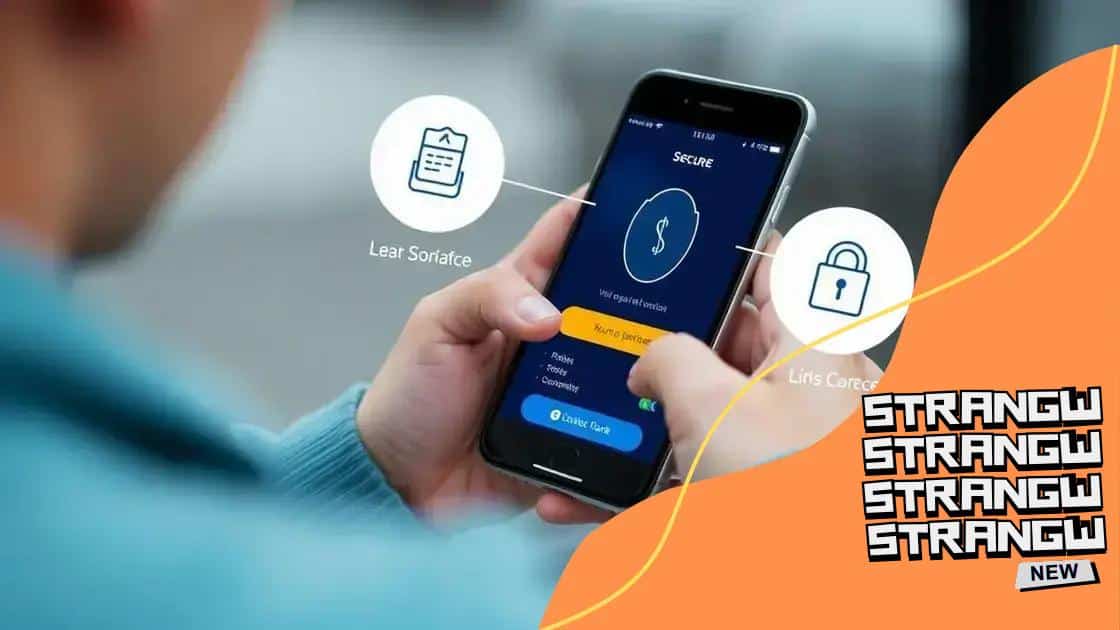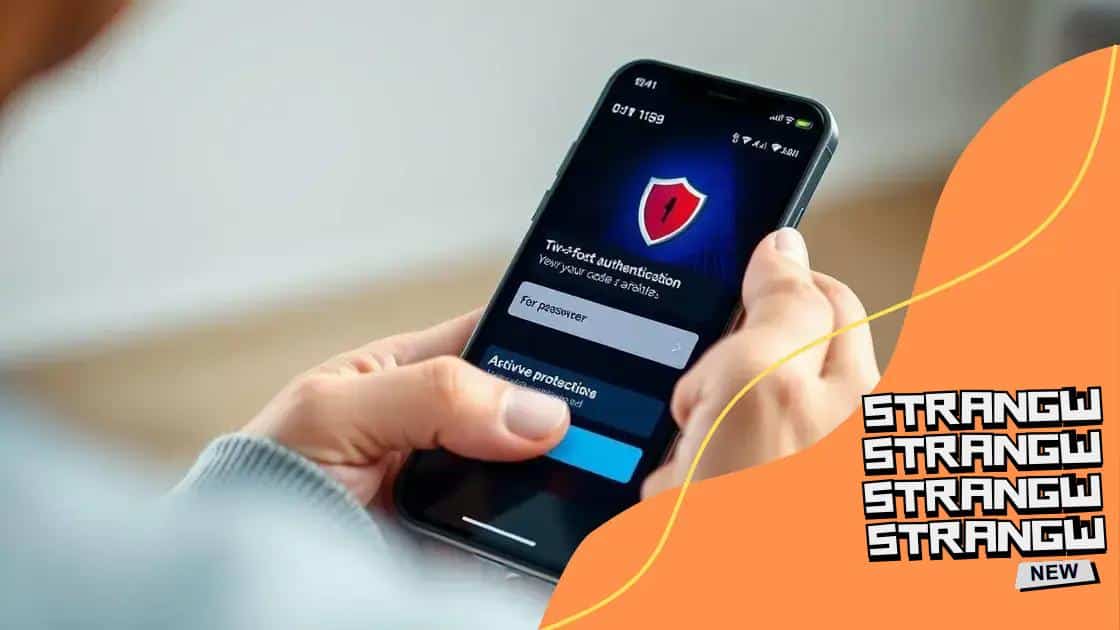Digital wallet security enhancements: securing your finances

To secure your digital wallet, use strong passwords, enable two-factor authentication, keep software updated, and be mindful of transaction security, especially on public networks.
Digital wallet security enhancements are crucial for keeping your financial information safe in an increasingly digital world. Have you ever worried about the safety of your transactions? Let’s explore essential strategies that can protect your wallet from threats.
Understanding digital wallet security measures
Understanding how to protect your digital wallet is essential for safe online transactions. Digital wallet security measures are designed to keep your financial information safe from hackers and fraud. By implementing these protections, you can enjoy peace of mind when using your wallet.
Key Security Features
Most digital wallets come with several key features to help you secure your information. These features often include:
- Two-factor authentication: This adds an extra layer of security by requiring a second form of identification.
- Encryption: Your data is scrambled, making it unreadable to anyone who might intercept it.
- Fraud detection: This monitors your transactions and alerts you to any suspicious activity.
- Password protection: Always use strong, unique passwords for your accounts.
While these features are crucial, it’s also important to stay informed about potential threats. Many users unknowingly compromise their security by not following best practices. For instance, never reuse passwords across different platforms, and always log out after your transactions.
Secure Connections
Always ensure you are using a secure connection when accessing your digital wallet. Look for HTTPS in the URL, indicating that the connection is secure. Public Wi-Fi networks can be risky, as hackers can intercept your data. Whenever possible, use your mobile data or a designated secure network.
Another essential aspect of digital wallet security measures is keeping your wallet software updated. Updates often include important security patches that protect against new vulnerabilities. Regular updates help ensure that your wallet remains safe from attackers.
In conclusion, understanding and implementing effective security measures is your best defense against digital wallet threats. By staying vigilant and informed, you can protect your financial future with confidence.
Common threats to digital wallets
Common threats to digital wallets can put your financial information at risk. Understanding these threats is vital for protecting your assets. With the rise of digital payments, numerous vulnerabilities have emerged that users should be aware of.
Phishing Attacks
One of the most prevalent threats is phishing. Scammers often send fraudulent emails or text messages that appear legitimate. They trick users into providing personal information like passwords or credit card numbers. Always be cautious and verify the source before clicking on links.
- Check the sender: Ensure the email or message comes from a known source.
- Look for typos: Many phishing attempts include spelling errors.
- Avoid sharing sensitive data: Legitimate companies will not ask for personal info via email.
Another common threat is malware. Malicious software can infect your device and steal your information. This could happen through downloading untrustworthy apps or clicking on unsafe links. Maintaining updated software and using security apps can help combat these threats.
Public Wi-Fi Risks
Public Wi-Fi networks also pose significant risks. Hackers can intercept your data when you’re connected to unsecured networks. It’s advisable to conduct financial transactions only on trusted networks. Whenever possible, use a Virtual Private Network (VPN) to encrypt your connection.
Lastly, account hacking is a serious concern. If your password is weak or reused across platforms, it becomes easier for hackers to gain access. Always create strong, unique passwords and consider enabling two-factor authentication. This adds an extra layer of security to your accounts and helps protect your wallet.
By being aware of these common threats to digital wallets, you can take proactive steps to secure your financial information. Staying informed and implementing security measures goes a long way in protecting your digital assets.
Best practices for securing your wallet

Best practices for securing your wallet are essential for protecting your financial information. Adopting these practices can significantly reduce the risk of fraud and theft, ensuring that your assets remain safe.
Strong Passwords
One of the first steps in securing your digital wallet is creating a strong password. Avoid easily guessed passwords, such as “123456” or “password”. Instead, use a combination of upper and lower case letters, numbers, and special characters. This makes it much harder for hackers to access your account.
In addition, consider using a password manager. These tools help generate and store complex passwords securely, so you don’t have to remember them all.
Enable Two-Factor Authentication
Enabling two-factor authentication (2FA) adds an extra layer of security. With 2FA, you’ll need to provide a second piece of information, such as a code sent to your phone, in addition to your password. This means that even if someone has your password, they still can’t access your account without this second factor.
- SMS codes: Many wallets offer codes sent via text.
- Auth apps: Apps like Google Authenticator provide secure codes.
- Email codes: Some services use email as your second factor.
Another valuable practice is keeping your software updated. Regular updates contain important security patches that keep your wallet protected from new vulnerabilities. This includes your wallet app as well as your device’s operating system and security software.
Secure Your Device
Your device also plays a crucial role in securing your wallet. Ensure that you have a reliable antivirus program installed. This can help detect and eliminate any threats before they compromise your information. Additionally, avoid downloading apps from untrusted sources, as these can be laden with malware designed to steal your data.
Being aware of your surroundings when using your digital wallet is also important. Avoid accessing sensitive information while using public Wi-Fi networks. When necessary, use a VPN to encrypt your internet connection, providing an added layer of protection against potential attackers.
By following these best practices for securing your wallet, you can safeguard your digital financial transactions and protect your sensitive information from threats.
How to choose a secure digital wallet
Choosing a secure digital wallet is a vital step in protecting your financial information. The right wallet can offer various features that enhance security, making your transactions safer and more convenient.
Research Wallet Types
First, it’s important to research the types of digital wallets available. There are three main types: hardware wallets, software wallets, and online wallets. Hardware wallets are physical devices and are often considered the most secure option. They store your information offline, making it harder for hackers to access.
Software wallets can be installed on your computer or smartphone and provide a good balance of accessibility and security. Online wallets, while convenient for quick transactions, are typically less secure due to being always connected to the internet.
Look for Security Features
When selecting a digital wallet, pay attention to its security features. A reputable wallet should offer:
- Two-factor authentication: This ensures only you can access your wallet, adding extra security.
- Encryption: Data should be encrypted, protecting it from unauthorized access.
- Backup options: The wallet should provide a way to back up your data securely.
- Regular software updates: Look for wallets that are frequently updated to fix security vulnerabilities.
In addition, check for user reviews and ratings. Feedback from other users can provide insights into the wallet’s reliability and security. Seek out wallets that have a proven track record of safe transactions.
Evaluate User Experience
User experience is another important factor. The wallet should be easy to navigate and use, allowing you to make transactions without hassle. Consider trying out the wallet with a small transaction to see how it performs in real time. A good digital wallet balances security with convenience.
In conclusion, choosing a secure digital wallet is essential for protecting your assets. By researching wallet types, looking for key security features, and evaluating user experience, you can find a wallet that meets your needs and keeps your finances safe.
Future trends in digital wallet security
Future trends in digital wallet security are rapidly evolving to meet the growing demand for secure online transactions. As technology advances, users need to stay informed about new security measures that can protect their financial information.
Biometric Authentication
One trend gaining momentum is biometric authentication. This method uses unique physical characteristics, such as fingerprints or facial recognition, to enhance security. By using biometrics, users can unlock their wallets quickly and securely, reducing the risk of unauthorized access.
Many smartphones already support biometric features, making this trend even more accessible. As digital wallets integrate these technologies, users can expect a more convenient and secure experience.
Blockchain Technology
Another exciting development is the integration of blockchain technology for greater security. Blockchain provides a decentralized way to store transaction data, making it much harder for hackers to alter or access sensitive information. This increased security could build more trust in digital wallets.
Enhanced transparency is also a benefit of blockchain. Users will have better visibility into their transactions, ensuring that they remain secure. As this technology matures, it could become a standard feature in many digital wallets.
Artificial Intelligence
Artificial intelligence (AI) is also set to play a key role in future wallet security. AI can analyze transaction patterns and detect fraudulent activities in real time. By leveraging machine learning algorithms, digital wallets can improve their fraud detection capabilities, providing users with increased protection.
- Real-time alerts: AI can send immediate notifications for suspicious activities.
- Automatic learning: The technology adapts to individual user behavior, enhancing security.
- Personalized security measures: AI can recommend tailored settings for improved protection.
As digital wallets continue to grow in popularity, understanding these future trends will be crucial for users. Keeping informed about biometric options, blockchain advancements, and AI improvements can help ensure that your wallet remains a safe and secure option for transactions.
In conclusion, securing your digital wallet is more important than ever as online transactions become commonplace. By implementing best practices like strong passwords, two-factor authentication, and staying informed on future trends such as biometric authentication and AI, users can protect their financial information effectively. Understanding the risks and being proactive in your security measures will ensure a safer digital experience. Remember that knowledge is your best defense against potential threats!
FAQ – Frequently Asked Questions about Digital Wallet Security
What are the best practices for securing my digital wallet?
To secure your digital wallet, use strong passwords, enable two-factor authentication, keep your software updated, and avoid public Wi-Fi for transactions.
What should I look for in a secure digital wallet?
Look for features like biometric authentication, encryption, backup options, and a proven track record of secure transactions.
How can I stay informed about future trends in digital wallet security?
Follow reputable tech news sources, subscribe to security blogs, and attend webinars to learn about new developments in digital wallet security.
What is two-factor authentication and why is it important?
Two-factor authentication is a security measure that requires two forms of verification to access your wallet, making it much harder for unauthorized users to gain access.





